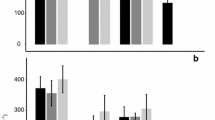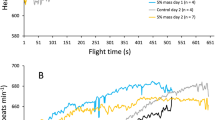Summary
Pulmonary ventilation (tidal volume, frequency) and oxygen content of expired air were measured in separate flights for 3 species of birds — Evening Grosbeak (Hesperiphona vespertina), Ring-billed Gull (Larus delawarensis), and Black Duck (Anas rubripes). Heart rate was measured in flight or immediately after landing in 12 species.
Respiratory frequency and tidal volume were greater in flight than during rest. As the O2 content of expired air did not change appreciably, the increase in O2 consumption was similar to the increase in ventilation and averaged more than 10 times basal. The influence of body weight on metabolism during flight was similar to that previously observed under basal conditions.
Heart rates during flight (10 species), immediately after landing (12 species), and maximal rates from various authors (15 species) were in close agreement, and were 2–4 times as high as during rest. The heart rate decreased with increasing body weight according to the equation HRf=25.1 BW−0.16 (HR per sec, BW in g). In flight there was much less variation and there was a smaller decrease with increasing weight than during rest. Although the estimated stroke volume and heart size appear larger in birds, the ratio of these functions was similar to that in mammals.
Similar content being viewed by others
References
Asmussen, E.: Muscular exercise. In: Fenn, W. O., and Rahn, H. (eds.), Handbook of physiology, sect. 3: Respiration, vol. 2, p. 939–978. Washington: American Physiological Society 1965.
Berger, M., Hart, J. S., Roy, O. Z.: Respiratory water- and heat loss of the Black Duck during flight at different ambient temperatures. Canad. J. Zool. (1970).
—, Roy, O. Z., Hart, J. S.: The co-ordination between respiration and wing beats in birds. Z. vergl. Physiol. 66, 190–200 (1970).
Clark, A. J.: Comparative physiology of the heart. Cambridge: Macmillan 1927.
Crile, G., Quiring, D. P.: A record of the body weight and certain organ and gland weights of 3690 animals. Ohio J. Sci. 40, 219–259 (1940).
Dolnik, V. R., Gavrilov, V. M., Ezerskas, L. J.: Energy losses of small birds to natural migrational flight. Acad. Sci. Eston. SSR, Inst. Zool. and Bot., Reports 5th Baltic area Ornithol. Conf., Tartu, p. 65–67 (1963).
Drost, R.: Die Stoppuhr als Hilfsmittel beim Ansprechen fliegender Vögel. Vogelzug 4, 32–33 (1933).
Eliassen, E.: Preliminary results from new methods of investigating the physiology of birds during flight. Vogelzug 105, 234–237 (1963).
Groebbels, F.: Der Vogel, vol. 1. Berlin: Bornträger 1932.
Hart, J. S., Roy, O. Z.: Respiratory and cardiac responses to flight in pigeons. Physiol. Zool. 39, 291–305 (1966).
Hartman, F. A.: Heart weight in birds. Condor 57, 221–238 (1955).
Holt, J. P., Rhode, E. A., Kines, H.: Ventricular volumes and body weight in mammals. Amer. J. Physiol. 215, 704–715 (1968).
Jansky, L., Hart, J. S.: Cardiac output and organ blood flow in warm- and coldacclimated rats exposed to cold. Canad. J. Physiol. Pharmacol. 46, 653–659 (1968).
King, J. R., Farner, D. S.: Energy metabolism, thermoregulation and body temperature. In: Marshall, A. J. (ed.), Biology and comparative physiology of birds, vol. II, p. 215–288. New York and London: Academic Press 1961.
Lasiewski, R. C.: Oxygen consumption of torpid, resting, active and flying hummingbirds. Physiol. Zool. 36, 122–140 (1963).
—: Body temperatures, heart and breathing rate, and evaporative water loss in hummingbirds. Physiol. Zool. 37, 212–223 (1964).
—, Dawson, W. R.: A re-examination of the relation between standard metabolic rate and body weight in birds. Condor 69, 13–23 (1967).
—, Hubbard, S. H., Moberly, W. R.: Energetic relationships of a very small passerine bird. Condor 66, 212–220 (1964).
—, Lasiewski, R. J.: Physiological responses of the Bluethroated and Rivoli's Hummingbirds. Auk 84, 34–48 (1967).
—, Weathers, W. W., Bernstein, M. H.: Physiological responses of the Giant Hummingbird, Patagona gigas. Comp. Biochem. Physiol. 23, 797–813 (1967).
LeFebvre, E. A.: The use of D2O18 for measuring energy metabolism in Columba livia at rest and in flight. Auk 81, 403–416 (1964).
Nisbet, I. C. T.: Weight-loss during migration. Part II: Review of other estimates. Bird-Banding 34, 139–159 (1963).
—, Drury, W. H., Baird, J.: Weight-loss during migration. Part I: Deposition and consumption of fat by the Blackpoll Warbler Dendroica, striata. Bird-Banding 34, 107–138 (1963).
Odum, E. P.: The heart rate of small birds. Science 101, 153–154 (1945).
Oehme, H.: Flug und Flügel von Star und Amsel. Biol. Zbl. 82, 413–454, 569–587 (1963).
—: Über den Kraftflug großer Vögel. Beitr. Vogelk. 11, 1–31 (1965).
Pearson, O. P.: The metabolism of hummingbirds. Condor 52, 145–152 (1950).
—: Metabolism and heat loss during flight in pigeons. Condor 66, 182–185 (1964).
Raspet, A.: Biophysics of bird flight. Science 132, 191–200 (1960).
Rensch, B.: Organproportionen und Körpergröße bei Vögeln und Säugetieren. Zool. Jb., Abt. allg. Zool. u. Physiol. 61, 337–412 (1948).
Roy, O. Z., Hart, J. S.: A multi-channel transmitter for the physiological study of birds in flight. Med. and Biol. Engng. 4, 457–466 (1966).
Segrem, N. P., Hart, J. S.: Oxygen supply and performance in Peromyscus. Canad. J. Physiol. Pharmacol. 45, 531–541 (1967).
Tucker, V. A.: Oxygen consumption of a flying bird. Science 154, 150–151 (1966).
—: Respiratory physiology of house sparrows in relation to high-altitude flight. J. exp. Biol. 48, 55–66 (1968).
—: Respiratory exchange and evaporative water loss in the flying budgerigar. J. exp. Biol. 48, 67–87 (1968).
Wilkie, D. R.: The work output of animals: Flight by birds and man-power. Nature (Lond.) 183, 1515–1516 (1959).
Zeuthen, E.: The ventilation of the respiratory tract in birds. Kgl. danske Videnskap. Selskab, Biol. Medd. 17 (No 1), 51 pp. (1942).
Author information
Authors and Affiliations
Additional information
Issued as N.R.C.C. No. 11094.
The valuable technical assistance of Mr. B. Mackenzie and Mr. R. Charbonneau made this study possible. We are also indebted to Dr. Doris Jensen of McMaster University for providing facilities for tests on ring-billed gulls.
Rights and permissions
About this article
Cite this article
Berger, M., Hart, J.S. & Roy, O.Z. Respiration, oxygen consumption and heart rate in some birds during rest and flight. Z. Vergl. Physiol. 66, 201–214 (1970). https://doi.org/10.1007/BF00297779
Received:
Issue Date:
DOI: https://doi.org/10.1007/BF00297779




